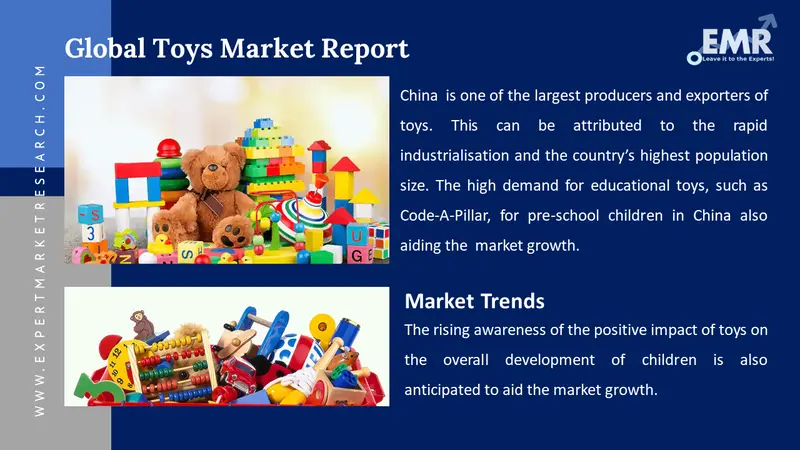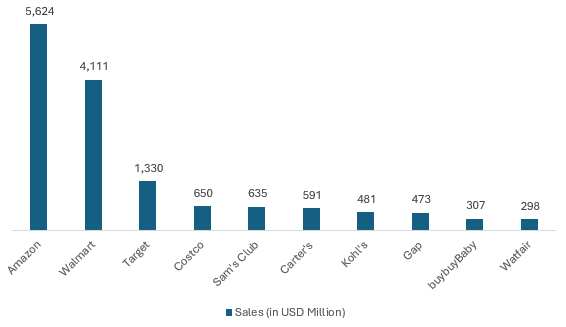

The toys market reached a value of approximately USD 108.29 billion in 2023. The market is projected to grow at a CAGR of 4.1% between 2024 and 2032, reaching a value of around USD 156.96 billion by 2032.
| Global Toys Market Report Summary | Description | Value |
| Base Year | USD Billion | 2023 |
| Historical Period | USD Billion | 2018-2023 |
| Forecast Period | USD Billion | 2024-2032 |
| Market Size 2023 | USD Billion | 108.29 |
| Market Size 2032 | USD Billion | 156.96 |
| CAGR 2018-2023 | Percentage | 3.7% |
| CAGR 2024-2032 | Percentage | 4.1% |
| CAGR 2024-2032 - Market by Region | Asia Pacific | 4.9% |
| CAGR 2024-2032 - Market by Country | India | 5.8% |
| CAGR 2024-2032 - Market by Country | Brazil | 4.7% |
| CAGR 2024-2032 - Market by Age Group | Up to 5 Years | 5.0% |
| CAGR 2024-2032 - Market by End Use | Online Channel | 7.1% |
| Market Share by Country | USA | 36.1% |

Read more about this report - REQUEST FREE SAMPLE COPY IN PDF
Toys, typically crafted from materials like wood, plastic, clay, or paper, serve as tools for children's play, often incorporating electronic elements. Engaging with toys aids in fostering logical thinking and spatial awareness, bolstering cognitive skills.
In regions like the Asia Pacific, Latin America, and the Middle East and Africa, robust economic growth presents promising prospects in the toys sector. Increasing environmental awareness among consumers, along with governmental regulations such as the Consumer Products Safety Improvement Act in the U.S., drives the demand for eco-friendly toys.
The toy market is propelled by factors like the influence of movies and TV shows, boosting demand for character-themed merchandise. Globally, revenue from movie-based toys surged by 19% in 2022. Additionally, the emergence of box subscription services is reshaping the market landscape.
These services customise toy selections based on children's preferences, exemplified by the debut of Little Bloomer. Their developmental toy boxes and accompanying apps cater to various stages of children's development, aiding parents in facilitating playtime.
INVEST India notes a significant 60% rise in India's toy exports from $203.46 Mn in 2018-19 to $325.72 Mn in 2022-23, per the Ministry of Commerce. Recent Free Trade Agreements, like with the UAE and the Middle East, grant Indian toy makers duty-free market entry, facilitated by deals like India-UAE CEPA and India-Australia ECTA.
Tech integration, sustainability, educational toys, and inclusivity and diversity are the major trends impacting the toys industry growth.
May 27, 2024
McFarlane Toys introduced a new DC Classic Darkseid Mega figurine, giving fans an exclusive preview. The design replicated Darkseid's iconic appearances in comics and other media.
May 16, 2024
Mattel's Fisher-Price launched a new line of wooden toys. Their extensive portfolio includes licensed items like a Darth Vader robot and football-themed Little People figures, now adding classic wooden toys.
April 23, 2024
deadmau5 introduced an "ultra-limited" line of plushie toys infused with blockchain technology. The 5,000 toys, available in six variants, were sold at his retro5pective shows and online store.
April 19, 2024
Steelbird Baby Toys enhanced child safety by launching baby helmets for cycling and skating, marking a strategic shift towards baby toys for Steelbird Hi-tech India's subsidiary.
Tech Integration
Toys are now integrating AR, VR, and AI to provide interactive and immersive experiences, including programmable robots, educational apps, and toys that connect with smartphones or tablets.
Sustainability
Increasing environmental awareness is driving demand for eco-friendly, sustainable toys made from recycled or biodegradable materials. Companies are reducing plastic usage and adopting sustainable manufacturing practices.
Educational Toys
Parents prioritise toys that educate and entertain, especially popular STEM toys aimed at developing children's skills in science, technology, engineering, and math.
Inclusivity and Diversity
Toy makers now prioritise inclusivity and diversity, creating toys reflecting diverse cultures, abilities, and backgrounds, including dolls with varied characteristics and ethnically diverse characters.
Toys fostering social interaction and teamwork thrive, especially for family and group activities. Board games, and cooperative sets, promote communication and teamwork.
In Europe, toys play a crucial role in child development, emphasising safety. The EU enforces stringent regulations to ensure toy safety, particularly regarding chemical usage, as outlined in the Toy Safety Directive.
Toys from popular franchises are significant. Licensing agreements drive sales of toys featuring beloved characters. Subscription toy services gain traction. Curating toys based on children's interests offers convenience for parents and enthusiasm for kids boosting the trends in toy industry.

Read more about this report - REQUEST FREE SAMPLE COPY IN PDF
“Toys Industry Report and Forecast 2024-2032” offers a detailed analysis of the market based on the following segments:
Market Breakup by Product
Market Breakup by Age Group
| CAGR 2024-2032 - Market by | Age Group |
| Up to 5 Years | 5.0% |
| 5 to 10 Years | 4.8% |
| Above 10 Years | XX% |
Market Breakup by Distribution Channel
| CAGR 2024-2032 - Market by | End Use |
| Online Channel | 7.1% |
| Traditional Stores | 3.4% |
| Departmental Stores | 3.3% |
| Hypermarkets and Supermarkets | XX% |
| Others | XX% |
Market Breakup by Region
Available Customizations:
We're here to assist you with tailored insights and solutions to ensure you have all the data you need for your strategic decisions.
Expert Market Research provides tailored reports to meet your unique business requirements. If you cannot find what you're looking for, please contact us at [email protected]
Action figures, a segment driven by product innovation, contribute significantly to the expansion of the toy industry market growth by fostering imaginative play. They empower children to invent their narratives, fostering creativity and honing storytelling abilities.
Action figures enable children to assume the roles of beloved characters, nurturing empathy and self-assurance through imaginative play. Collectable editions incite excitement, while educational themes facilitate learning. Interacting with these toys refines motor skills, emotional intelligence, and social aptitude, offering multifaceted developmental advantages.
Building sets cultivates creativity, dexterity, and problem-solving skills, integrating STEM education while promoting perseverance and social engagement. Their enduring appeal and educational significance offer limitless avenues for amusement and learning.
Games and puzzles stimulate cognitive abilities by enhancing problem-solving, critical thinking, and memory retention. They provide educational enrichment, foster social connections, familial closeness, entertainment, and relaxation, adaptable to diverse settings and occasions.
In terms of distribution channels, supermarkets and hypermarkets constitute a significant proportion of toy market share as it allows customers to conveniently make purchasing decision
Hypermarkets and supermarkets offer a convenient shopping experience by providing a wide range of toys at competitive prices. Located in easily accessible areas, they cater to budget-conscious customers who prefer not to visit speciality stores.
Toy stores and speciality outlets offer personalized assistance in toy selection, unique products, and interactive displays, creating an engaging shopping atmosphere. Focusing solely on toys, they foster community involvement through various events and workshops.
Online shopping provides convenience, diverse options, and accessibility, enabling customers to buy toys from anywhere. Features like price comparisons, customer reviews, and personalised services enhance the online shopping experience, catering to gifting and accessibility requirements.
Figure: Online Toy Sales by US Retailers: 2020 (USD Million)

The top players in toys market prioritise the creation of distinctive and captivating toy concepts, aiming to deliver unforgettable play experiences for children spanning various age groups.
Tomy Company Ltd., founded in 1924 and located in Tokyo, Japan, is a well-known toy manufacturer with a global reputation for its inventive and high-quality toys, covering various categories from early childhood playthings to action figures and collectables.
Simba Dickie Group, established in 1982 and situated in Fürth, Germany, is a prominent multinational toy enterprise recognized for its broad assortment of toys, including dolls, action figures, vehicles, and outdoor play items.
Moose Toys Ltd., founded in 1985 and based in Melbourne, Australia, is a highly acclaimed toy company lauded for its original and inventive methods in toy creation, emphasizing engagement and entertainment for children worldwide.
Spin Master Corporation, established in 1994 and headquartered in Toronto, Canada, is a dynamic and forward-thinking enterprise in the toy and entertainment sector, acknowledged for its extensive range of beloved brands and products, encompassing toys, games, television, and digital entertainment ventures.
Other global toys market key players are Hasbro, Inc., Mattel, Inc., Funko, Inc. and LEGO System A/S among others.
The Asia Pacific region is set to maintain its leading position in the toy market in the foreseeable future. The Asia Toy & Play Association (ATPA) works closely with regional governments to ensure the development of safe, high-quality toys and organises key events like the Hong Kong Toys and Games Fair and Spielwarenmesse. Additionally, associations like the All India Toys and Baby Products Association (AITBA) and the Asian Committee of Toy Industries play crucial roles in bolstering the growth of the toy market in the Asia Pacific region.
According to the Health and Welfare Ministry of Japan, 758,631 infants were born in Japan in 2023 and India's annual birth rate of 25 million children, accounting for nearly twenty per cent of global yearly births, as reported by UNICEF, consequently, enhances the demand for the toys market.
| CAGR 2024-2032 - Market by | Region |
| Asia Pacific | 4.9% |
| Latin America | 4.6% |
| North America | 4.0% |
| Europe | XX% |
| Middle East and Africa | XX% |
In North America, the rising demand for toys promoting self-care and social interaction is driving market growth, especially fueling interest in educational toys in the United States. Popular toy brands such as Pokémon, Star Wars, Barbie, Marvel, Squishmallows, Fisher-Price, Hot Wheels, L.O.L. Surprise!, and LEGO Star Wars are among the top sellers in both the US and Canada.
Building and construction toys are widely popular across 17 European countries, including Slovenia (LEGO), the UK (Stickle Bricks), and Liechtenstein (LEGO). The increasing demand for environmentally friendly toys, coupled with consumers' strong purchasing power, significantly contributes to the expansion of the toy market in Europe.
In Australia in 2023, the Ministers from the Department of Social Services in Australia announced that the Albanese Labor Government had reaffirmed its commitment to Australian children and families. This was demonstrated by allocating an extra $700,000 in funding to Toy Libraries Australia. According to the Department of Social Services, Toy Libraries Australia caters to more than 130,000 Australians, with toys valued at $28 million, averaging $640 per family member.
| CAGR 2024-2032 - Market by | Country |
| India | 5.8% |
| China | 5.0% |
| Brazil | 4.7% |
| Australia | 4.3% |
| USA | 3.9% |
| Canada | XX% |
| UK | XX% |
| Germany | 3.8% |
| France | XX% |
| Italy | XX% |
| Japan | XX% |
| Saudi Arabia | XX% |
| Mexico | XX% |
| Market Share by | Country |
| USA | 36.1% |
| Canada | XX% |
| UK | XX% |
| Germany | XX% |
Recent advancements in the toy market growth involve the integration of technology such as augmented reality (AR), virtual reality (VR), and artificial intelligence (AI), resulting in interactive gaming encounters. Sustainability is highlighted, emphasising the use of environmentally friendly materials and methods. Inclusivity and diversity are given precedence, as toys now represent a variety of cultures, abilities, and backgrounds to cater to changing consumer demands.
Toys market challenges arise from supply chain interruptions triggered by events such as the pandemic, trade conflicts, and logistical complications, resulting in manufacturing and distribution delays. Meeting strict safety regulations demands substantial investment, notably in regions like the EU and US. Moreover, traditional toy manufacturers face pressure to innovate and maintain consumer engagement amidst competition from digital entertainment.
The global toy industry demonstrates consistent expansion propelled by increasing disposable income and the desire for novel toys. Regional trends differ, with North America and Europe spearheading developed markets, while the Asia Pacific region experiences swift advancement. Significant trends include integrating technology, emphasising sustainability, and promoting inclusivity further boosting the toys market future outlook.
According to the ITC Trade Map, the largest global importer and exporter of toys in 2022, games, sports requisites, and their parts and accessories (HS Code 95) are:
Historical and Forecast Trends, Industry Drivers and Constraints, Historical and Forecast Market Analysis by Segment: